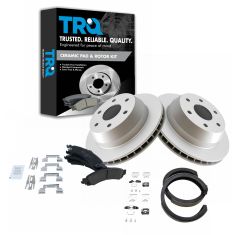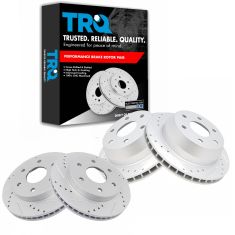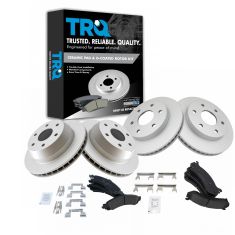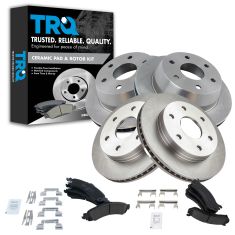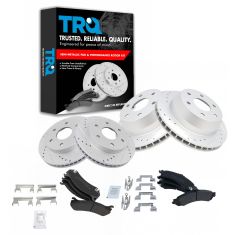1APBS00072-Chevrolet GMC Cadillac Rear Ceramic Performance Brake Pad & Rotor Kit TRQ Performance BKA12095
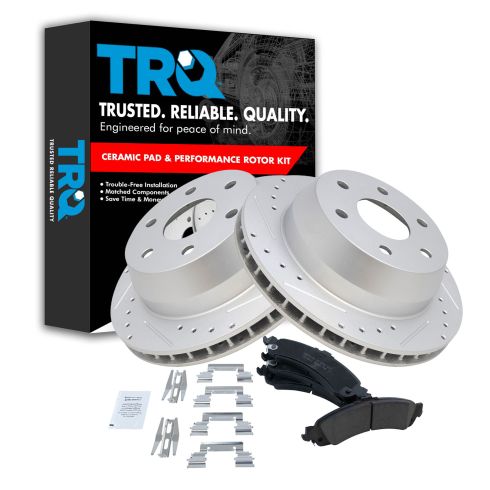
Replaces
2000 Chevrolet Tahoe Rear Wheel Drive with 13 in. (330mm) Diameter Rear Rotors with Dual Piston Rear Calipers without Z71 Package Rear Ceramic Performance Brake Pad & Rotor Kit TRQ Performance BKA12095

Product Reviews
Loading reviews
5.00/ 5.0
11
11 reviews
March 15, 2017
Best price compared to other places fit just fine on my yukon denali 2003 will be buying them again and again
Brake rotors kit
March 30, 2018
Good stuff! Parts were good and fit well. Goooood price.
Great Product
August 4, 2018
Way better value than the box store fast shipping was amazing
Brake Kit (Rear) - Excellent!
August 28, 2018
When the order arrived, the external box that the kit was packed in was completely trashed. Almost to the point of being useless! However, the box containing the kit (Nakamoto packaging) was in great shape! So, no worries!
The parts arrived exactly as promised! Im sure UPS doesnt like the almost 50lb package!! :-/
The install was very smooth and all parts fit to perfection! No "adjustments" required (2001 Tahoe). The fit and finish of the rotors and pads seems to be very good quality! No squeaks or squeals, just smooth, predictable braking! No grabbing or anything out of the norm!
So far, I *highly* recommend the Nakamoto rotors and pads -- and, of course, the AWESOME 1A Auto!!
NAKAMOTO vented rotor brake kit.
February 19, 2019
Good customer service spoke to a sales rep before ordering confirming fitment and it was successful. Prior to this I attempted to order the same kit from another online parts distributor which will remain anonymous but received parts that did not fit my vehicle; they didn’t even try to resolve the mistake and just asked that I return the parts. I’m glad 1Aauto knows what they’re doing and will order from them from here on out. As for the brake kit, for the price it’s packaged well, high quality and I’m satisfied with it’s performance. I probably wouldn’t say it’s the highest performing part but still very well made and works for daily driving. If you do a lot of hauling or even racing I would recommend spending a little more on a different brand.
Great rotors
September 10, 2019
Rotors look great but best of all was the price.Very satisfied with the product.
Great Quality
April 14, 2021
Bought this rotor and pad set for my 2004 Suburban. I use this as a tow vehicle for my boat and needed stopping power. Received the order within 5 days and what a difference from the stock parts. Installed and they performed as expected stopping with the extra weight of the boat.
Highly recommend!
tahoe rear rotors and pads
August 10, 2021
good stuff
Stopping on a dime.
July 14, 2023
Great product. Fit perfectly on my Z71. Arrived on time. Will be purchasing more parts from 1A. Plus the videos and supply list needed for the work you will do are at your fingertips and really made the job less stressful.
[{"url": "https://wac.edgecastcdn.net/001A39/prod/media/pNISJll75W64CYGsite/9724b014dd608460de1098e12e8c304b_1693397697654_0.jpeg", "caption": "Installed on my 2004 Escalade, smooth and quiet stops on a dime"}]
August 30, 2023
Can't beat the price easy to install great product looks good too.
May 13, 2024
Worked as should
Customer Q&A
No questions have been asked about this item.
Chevrolet is a registered trademark of General Motors Company. 1A Auto is not affiliated with or sponsored by Chevrolet or General Motors Company.
See all trademarks.









